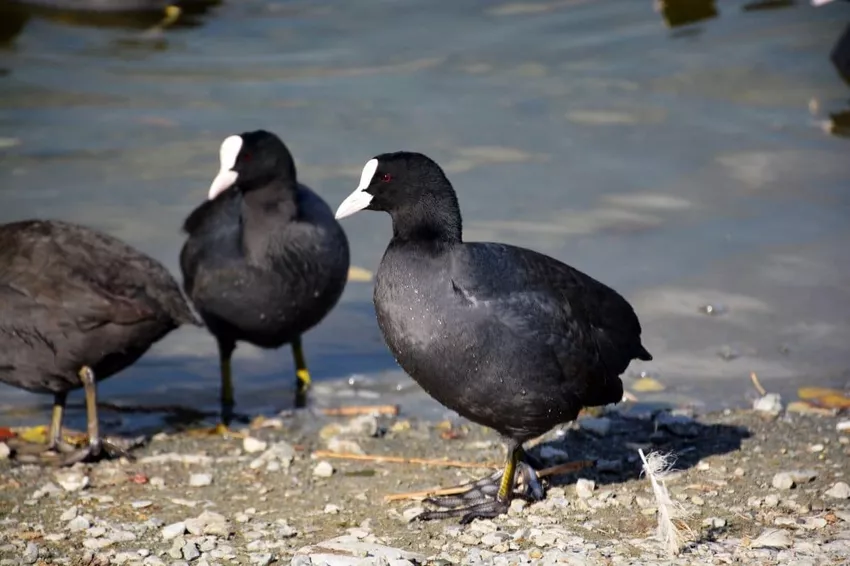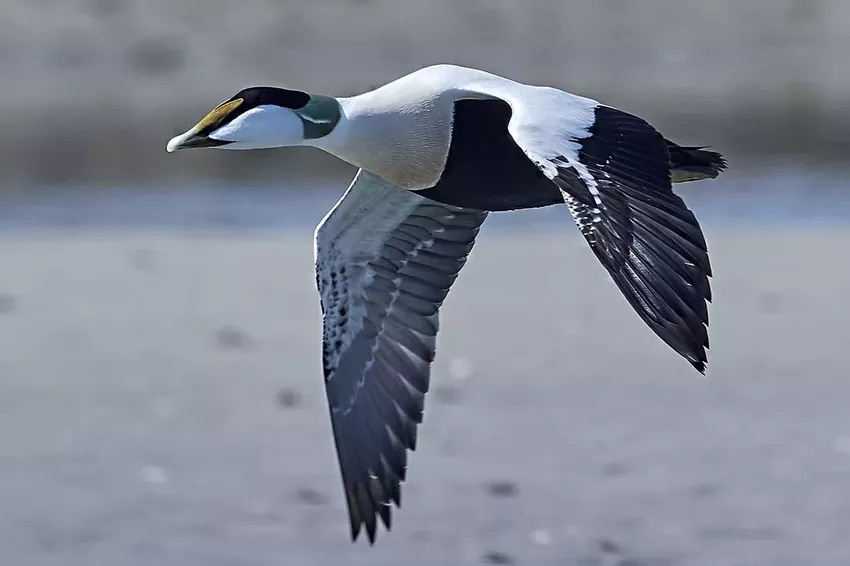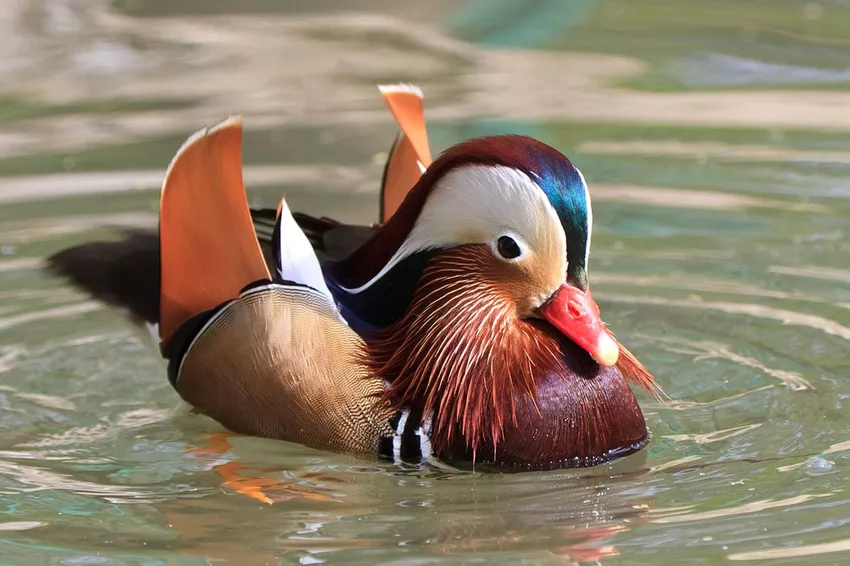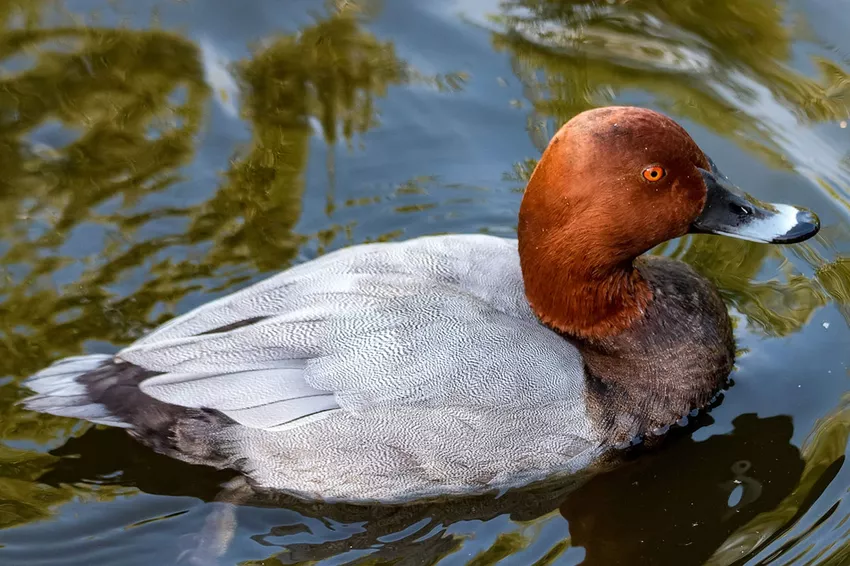
Various ducks can be observed at lakes, streams and ponds. While the females are often inconspicuous, many males fascinate with their colorful plumage. Learn how to recognize a native duck species.
In a nutshell
- The anatidae family (Anatidae) includes more than 150 water bird species
- about 20 species native to Germany
- Exposure to climate change, plastic waste and fishing
- Duck is the name for female birds, drake or drake for male ones
- wide body shape allows swimming
domestic ducks
Ducks live in pristine waters in nature, but also in village ponds and small streams, even in artificial lakes. The male ducks, the drakes, often impress with brightly colored plumage. The females are usually colored plainer in gray or brown. We have compiled the characteristics of the respective native duck species for you.
Types from A - D
Scaup (Aythya marila)
 Source: Calibas, Greater-scaup-male2, edited from Plantopedia, CC BY-SA 4.0
Source: Calibas, Greater-scaup-male2, edited from Plantopedia, CC BY-SA 4.0
- Length: 42 to 52 centimeters
- Features:
- wide beak with a white edge
- round head
- Males in breeding plumage black in front and behind, light in the middle, less contrasting in plain plumage
- Females are dark brown with a white beak base
- Habitat: lakes, rivers
- Food: mussels, frogs, snails, insects
- Nest building: near water on the ground
- Breeding season: May to June, one annual brood
- Migration behavior: Medium and long-distance migrants
- Danger: no
Notice: This duck species looks confusingly similar to tufted ducks.
Coot (Fulica atra)

- Length: 36 to 38 centimeters
- Features:
- stocky, broad body
- black-grey plumage, black head with white forehead shield
- Beak white with a pink tip
- Legs grey-green, feet with swimming rags
- Habitat: lakes, ponds, swamps, rivers
- Food: parts of plants, grain, grass, fish, snails, insects
- Nest building: in the riparian vegetation, on the ground
- Breeding season: April to August, two annual broods. Migration: Short-distance migrant or resident
- Danger: no
Notice: Coots can walk over water lilies because of their large, wide feet. This species of duck can be seen all year round.
wood duck (Aix sponsa)

- Length: 44 to 50 centimeters
- Features:
- Male: Magnificently colored, head, crest and back glossy green, white stripes on head, black cheeks
- Females: grey-brown, chin and throat white, beak yellow, white eye ring
- Habitat: on the banks of small bodies of water
- Food: Insects, beetles, spiders, snails, nuts, grain, acorns, parts of plants
- Nest building: near bodies of water, in hollow trees, in abandoned burrows
- Breeding season: May to June, one annual brood
- Migration behavior: sedentary bird
- Danger: no
Types of E - G
Common eider (Somateria mollissima)

- Length: 50 to 70 centimeters
- Features:
- compact body with a short neck and triangular beak
- the heaviest sea duck, weighing two kilograms
- Males: Black and white in breeding plumage with green nape colouration
- Females: grey-brown
- Habitat: North and Baltic Sea coasts, rarely inland
- Food: mussels, crabs
- Nest building: on the coast in seaweed
- Breeding season: April to July, one annual brood
- Migration: Short-distance migrant or resident bird
- Danger: yes
Notice: The main source of food for this species of duck is mussels. These are swallowed whole and broken up in the stomach with the help of small stones.
Long-tailed Duck (Clangula hyemalis)

- Length: 40 to 47 centimeters
- Features:
- petite body
- Male: Black-brown with a white crest and a long spiked tail
- Female: brown with white face
- Habitat: only in winter on the North and Baltic Seas
- Food: Mussels, crabs, insects, snails
- nesting:
- Breeding season: May to July, one annual brood
- Migration behavior: migratory bird
- Danger: yes
Loon (Gavia immer)
 Source: ADJ82, CommonLoon-1APR2017, edited from Plantopedia, CC BY 4.0
Source: ADJ82, CommonLoon-1APR2017, edited from Plantopedia, CC BY 4.0
- Length: 69 to 91 centimeters
- Features:
- strong, stocky body
- black with white dotted neck ring and white square pattern on the back
- big beak
- Habitat: only in winter on the North and Baltic Seas, partly on Lake Constance
- Food: Fish, frogs, mussels, crabs, insects, snails, parts of plants
- Nest building: bank area of standing water
- Breeding season: April to July, one annual brood
- Migration behavior: migratory bird
- Danger: no
Goosander (Mergus merganser)

- Length: 60 to 69 centimeters
- Features:
- long, bulky body
- red beak with saw teeth and hooks
- Male: white body, black head, black back, white wing spots
- Females: blue-grey body, brown head
- Habitat: on clean rivers with gravel bottom
- Food: fish, crustaceans, insects, larvae
- Nest Building: Cave breeder, breeds in tree and rock cavities
- Breeding season: April to June, one annual brood
- Migration behavior: migratory bird
- Danger: yes
Types of H - K
Great crested grebe (Podiceps cristatus)

- Length: 46 to 50 centimeters
- Features:
- long neck, raised hood
- Males: black tuft, red-brown ruff, white sides of head, clear eye stripe
- Females: similar, less contrasting
- Habitat: Lakes and fishponds
- Food: Fish, tadpoles, frogs, newts
- Nest building: in the water
- Breeding season: March to June, one annual brood
- Migration behavior: sedentary bird
- Danger: no
Notice: The male of this duck species courts the female with the conspicuous penguin dance.
Garganey (Anas querquedula)

- Length: 37 to 41 centimeters
- Features:
- Male: Brown with tan wings, white wedge from head to nape
- Females: grey-brown, grey-white head, gray beak
- Habitat: Shallow, vegetated waters
- Food: Mussels, crabs, insects, worms
- Nest building: in dense riparian vegetation
- Breeding season: April to September, one annual brood
- Migration behavior: long-distance migrant
- Endangerment: Critically Endangered
Pochard (Netta rufina)

- Length: 45 to 56 centimeters
- Features:
- Male: orange-red, bushy head, red beak
- Female: brown with dark head and white cheeks, gray beak
- Habitat: Lakes and ponds
- Diet: aquatic plants, insects, larvae, worms
- Nest building: on the ground near the shore
- Breeding season: April to June, one annual brood
- Migration behavior: short-distance migrants
- Danger: yes
Teal (Anas crecca)

- Length: 34 to 38 centimeters
- Features:
- Male: gray plumage, head reddish brown-green patterned, gray bill, yellow rump
- Females: brown, bill orange-grey, lighter rump
- both sexes with green wing tips
- Habitat: Lakes, bogs, wetlands
- Food: parts of plants, crustaceans, mussels, insects
- Nest building: in dense riparian vegetation
- Breeding season: April to June, one annual brood
- Migration behavior: migratory bird
- Danger: no
Types of L - R
Shoveler (Anas clypeata)

- Length: 48 to 52 centimeters
- Features:
- Male: with blue-green iridescent head and neck, brown belly and flanks, dark back, spoon-like beak
- Females: Brown and white patterned, bill edged with orange-red
- Habitat: Fish ponds, moorland
- Food: small aquatic animals, insects, worms, seeds
- Nest building: near the bank on the ground
- Breeding season: April to June, one annual brood
- Migration behavior: migratory bird
- Danger: yes
Mandarin duck (Aix galericulata)

- Length: 41 to 49 centimeters
- Features:
- glossy duck
- Males strikingly colourful, green tuft, red-brown whiskers, white stripes over the eyes, orange wings
- Females grey-brown patterned, white eye-ring
- Habitat: by ponds and in parks
- Diet: aquatic plants, fish spawn, insects
- Nesting: Cave breeder, breeds in tree cavities
- Breeding season: April to June, one annual brood
- Migration behavior: sedentary bird
- Danger: yes
Notice: In China, the mandarin duck is a symbol of marital fidelity. The pairs of this duck species are monogamous and usually stay together their entire lives.
Moor duck (Aythya nyroca)

- Length: 34 to 38 centimeters
- Features:
- both sexes chestnut-brown back, white-grey belly, dark beak
- Male: white eyes
- Females: black eyes
- Habitat: Shallow water bodies with many aquatic plants
- Food: aquatic plants, small fish, insects, snails
- Nest building: on the ground near the shore
- Breeding season: April to June, one annual brood
- Migration behavior: migratory bird
- Danger: yes
Types from S - Z
Mallard (Anas platyrhynchos)

- Length: 55 to 60 centimeters
- Features:
- Male: green head, brown breast, yellow bill, blue wing feathers, glossy plumage
- Females: brown, orange-red beak
- Habitat: along flowing water
- Food: parts of plants, insects, small aquatic animals
- Nest building: near the bank on the ground and in tree cavities
- Breeding season: March to July, one annual brood
- Migration behavior: sedentary bird
- Danger: no
Pochard (Aythya ferina)

- Length: 48 to 50 centimeters
- Features:
- Male: chestnut brown head and neck, red eyes, black beak, black breast, silver gray body and wings, gray legs
- Females: Brown head, white-rimmed eyes, dark gray bill, reddish-brown body
- Habitat: At lakes and fish ponds with lots of vegetation
- Food: aquatic plants, insects, worms
- Nest building: floating nests in the reeds
- Breeding season: April to June, one annual brood
- Migration behavior: sedentary bird
- Danger: yes
frequently asked Questions
What natural enemies do domestic ducks have?Ducks and their young are threatened by raptors such as white-tailed eagles, hawks and hawks. Large fish such as pike are considered natural enemies. The proliferation of raccoons and foxes poses another threat to ducks.
Does it make sense to feed ducks in nature?Feeding ducks, swans and seagulls is fun for both children and adults. Never feed the birds bread, as this is not part of the animals' natural diet. Bread feeding accelerates the formation of algae and pollution of water bodies. If you want to feed ducks, get information from a conservation association. In some regions, feeding is prohibited and punishable by fines.
How can you help protect ducks?Avoid plastic wherever you can. Plastic waste is one of the biggest threats to waterfowl. Do not disturb ducks during breeding season. Create a habitat for small animals and insects on your property, some of which are the ducks' food.